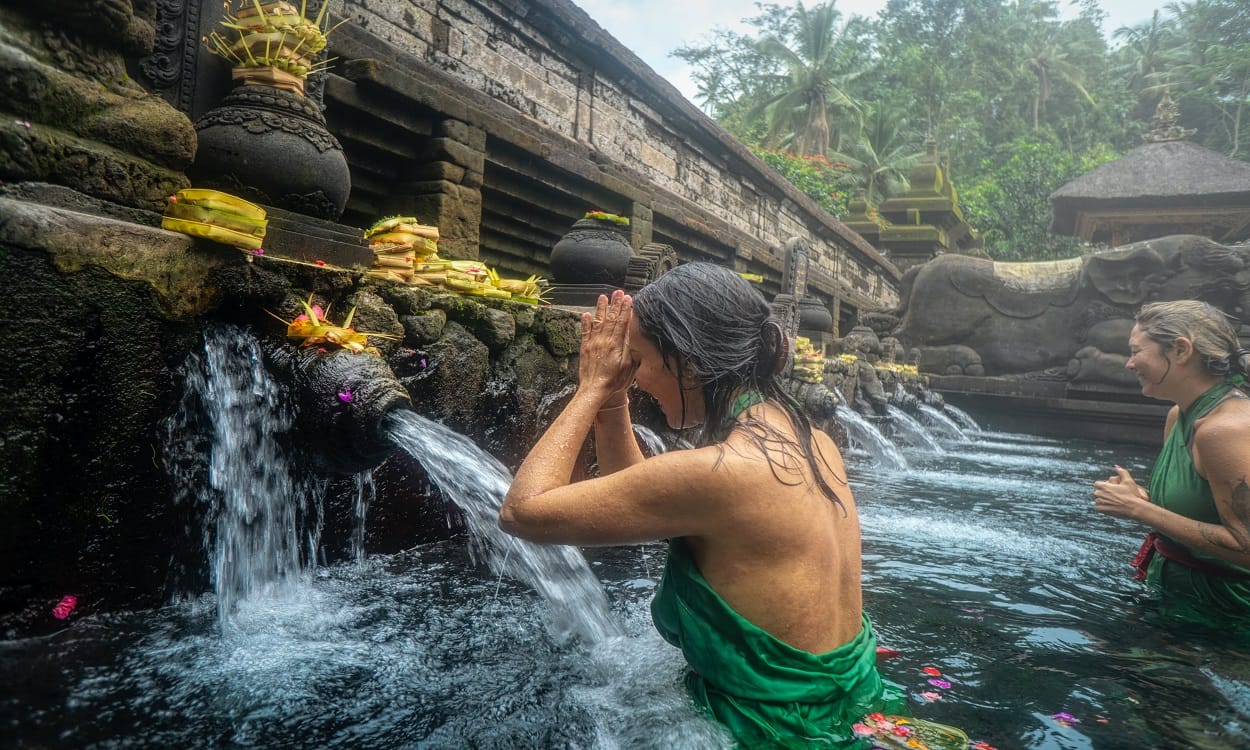Welcome to the magical realm of Tirta Empul Temple, where Bali’s spiritual roots run deep. Let’s delve into the stories behind this awe-inspiring place, from its mystical origins to its beautiful architecture, and uncover the secrets of its enduring religious traditions. Dive in and discover the enchanting power of this sacred sanctuary!
History of Tirta Empul Temple
Nestled in the heart of Bali, Indonesia, the Tirta Empul Temple, established in 962 AD, is more than just a place of worship. It’s a place where ancient history, stunning craftsmanship, and the spirit of belief intertwine. For over a thousand years, this Hindu water temple has served as a beacon of faith, attracting both locals and travelers to its sacred waters.
The name “Tirta Empul,” meaning “Holy Spring Water,” hints at the magic held within. Legend suggests that the spring, which flows through the temple grounds, possesses a unique power—the ability to cleanse and heal. This belief has drawn people to these waters for centuries, seeking blessings and renewal.
Dedicated to Vishnu, the Hindu deity often associated with preservation, the temple reflects Balinese architectural genius. It’s laid out in three distinct sections:
- Jaba Pura (Front Yard): As the welcoming point, this space allows you to feel the temple’s energy wash over you.
- Jaba Tengah (Central Yard): Here, you’ll find the famed purification baths, fed by the sacred spring. Rows of intricately carved spouts pour forth water believed to carry blessings and renewal.
- Jeroan (Inner Yard): This most sacred part of the temple provides a space for quiet reflection and deeper connection.
While the spring at Tirta Empul has long been a source of life and purity for the Balinese people, challenges have arisen in recent times. Concerns about potential pollution affecting the water quality have prompted authorities to actively investigate these issues, working to preserve the sanctity of this ancient site.
Even with these hurdles, Tirta Empul Temple remains a place of immense spiritual significance, buzzing with activity and alive with the devotion of Balinese Hindus. Its captivating history, timeless beauty, and the palpable sense of faith that permeates the air make it much more than a tourist destination—it’s a journey into the heart of Balinese culture and a testament to the enduring power of belief.
What is the significance of Tirta Empul Temple?
Tirta Empul Temple, a living center of Balinese Hindu faith, has drawn locals and travelers for centuries. Its name, “Holy Spring Water,” speaks volumes about its significance. The natural spring, bubbling up from the earth, is believed to hold the power to purify the soul.
While the legend of a god creating this spring with a lightning bolt remains a story, what we do know is that people have sought its blessings since at least the 10th century, making Tirta Empul one of the oldest and most revered holy sites on the island.
Balinese Hindus believe that this water, a gift from the gods, can wash away negativity, bad luck, and even past mistakes. This spiritual cleanse, known as “melukat,” involves waiting patiently for their turn to step under each of the waterspouts, offering prayers with every drop.
Beyond the sacred spring, the entire temple complex is a sight to behold. A grand stone gate welcomes visitors into a courtyard that feels both ancient and alive. Shrines dedicated to various Hindu deities, each with its own story, showcase the dedication and artistry of the Balinese people.
Tirta Empul is a place for everyone. Locals gather here for festivals, ceremonies, and even casual gatherings with friends and family. The air hums with activity, a mix of prayers and laughter, ancient rituals and modern life.
Even today, archaeologists and historians continue to uncover new layers of meaning at Tirta Empul. Inscriptions, hidden pathways, and fragments of pottery—each discovery adds to the puzzle, deepening our understanding of this remarkable place.
A visit to Tirta Empul is more than just a trip to a beautiful location; it’s a journey into the heart of Balinese culture and spirituality. The temple invites you to slow down, reflect, and perhaps connect with something larger than yourself.
What does Tirta mean in Balinese?
In Bali, “Tirta” signifies “holy water,” specifically the kind that flows through temples like the renowned Tirta Empul Temple. Imagine crystal-clear water gushing from ancient springs, believed to possess the power to cleanse your soul and heal your body.
For the Balinese people, this belief is a way of life. They bathe in these sacred springs, including the one at Tirta Empul, to wash away their troubles and emerge renewed.
Tirta’s significance extends beyond personal purification. This holy water is also used in religious ceremonies, where it’s believed to carry blessings and connect people to the divine. Tirta Empul Temple, dedicated to Vishnu, the Hindu god of water, stands as a testament to this profound reverence.
Think of “Tirta” as a spiritual oasis, where the power of water and the presence of the divine intertwine, carrying the weight of ancient beliefs and the promise of spiritual renewal.
What is the Sacred Pool of Tirta Empul?
At the heart of Tirta Empul’s magic lies the sacred pool. This isn’t just any pool; it’s filled with crystal-clear water that locals believe has the power to purify and heal, making it a sacred spot for Balinese Hindus for centuries.
People come from all over to bathe in these special waters, hoping to wash away any negativity and leave feeling refreshed and at peace.
What makes this pool even more fascinating is that it’s fed by 30 different spouts. Tradition holds that each spout has its own purpose, from boosting mental clarity to warding off evil spirits.
This bathing ritual, known as “melukat,” is a deeply spiritual experience. People pray, meditate, and chant mantras, fully immersing themselves in the experience. The sound of the water, the scent of incense, and the warmth of the sun all contribute to a profound connection with the divine.
Built in 926 AD, Tirta Empul has been a hub for worship and pilgrimage ever since. Its breathtaking architecture, with intricate carvings and designs, speaks to the island’s rich cultural heritage and the enduring strength of Hindu traditions.
What is the oldest temple in Bali?
Many believe that the title of the oldest temple in Bali belongs to the incredible Besakih Temple, situated high on the slopes of Mount Agung. This sprawling complex of 23 interconnected temples, each dedicated to a different god or goddess, is considered the holiest Hindu temple on the island.
Mount Agung, the volcano on which Besakih sits, has erupted numerous times over the centuries. Remarkably, Besakih has survived each eruption relatively unscathed. Many locals interpret this as a sign that the temple is protected by divine powers.
While Besakih is widely accepted as the oldest, some scholars suggest that smaller temples hidden in remote areas of Bali could be even older. Dating these ancient sites accurately is a challenging task, and further research may uncover even more secrets.
What is the difference between Tirupati and Tirumala?
Tirupati and Tirumala, often mentioned together, are located in close proximity in the Chittoor district of Andhra Pradesh in India. However, they offer distinct experiences.
Tirumala, situated atop the Tirumala hills, is home to the renowned Tirumala Venkateswara Temple. This peaceful mountaintop retreat attracts millions of pilgrims annually who seek blessings and a deeper connection with their spirituality.
In contrast, Tirupati, the bustling city at the base of the mountain, serves as the primary accommodation hub for temple visitors. With hotels, restaurants, and shops, Tirupati caters to the practical needs of pilgrims.
Essentially, Tirumala centers around the religious experience, with pilgrims engaging in prayer, rituals, and offerings. Tirupati facilitates this experience, providing essential services and amenities.
Here’s a simple breakdown:
- Tirumala: Mountaintop location, serene atmosphere, focused on the temple and spirituality.
- Tirupati: Bustling city, practical amenities, a place to prepare for and rest after a temple visit.
While different, both Tirupati and Tirumala hold significance for Hindu pilgrims, offering unique experiences tailored to meet diverse needs.
What was the significance of the temple?
Temples like Tirta Empul played a vital role in ancient communities, serving as more than just places of worship. They were the heart and soul of the community in numerous ways.
Dedicated to Vishnu, the god of water and balance, Tirta Empul held deep significance for the Balinese people who lived on an island surrounded by water. The temple likely fostered a strong connection to their beliefs, allowing them to tap into something larger than themselves.
The belief in the healing properties of the holy spring, whether scientifically proven or not, had a profound impact on the lives of believers. The act of immersing themselves in those pools likely brought a sense of peace and release from worries.
Tirta Empul also served as a gathering place for the entire community. Festivals and ceremonies celebrated shared culture and history, fostering unity and a sense of belonging among the people.
The temple’s enduring presence through centuries of natural disasters likely instilled a sense of hope and resilience in the community. Tirta Empul stood as a living link to their ancestors, a reminder that they were part of something ancient and enduring.
In essence, temples like Tirta Empul transcended their religious function. They were sacred spaces, community centers, symbols of hope, and much more.
What is the importance of Thirunavaya Temple?
The Thirunavaya Temple holds a special place in Hindu tradition, particularly for those who follow Vishnu. Its significance is multifaceted, encompassing religious, ritualistic, historical, and architectural aspects.
Firstly, Thirunavaya Temple is one of the 108 Divya Desams—sacred temples dedicated to Vishnu. Here, he is revered as Navamukunda Perumal, alongside Goddess Lakshmi and Gajendra, the elephant king.
Adding to its sanctity, the Bharatappuzha River flowing by Thirunavaya is considered as holy as the Ganges. Hindus believe that performing “pitru tharpanam” (ancestral rituals) by this river brings peace to departed souls.
Thirunavaya Temple was also once the venue for the grand Mamankam festival, a 12-year event that drew large crowds. While no longer held, the festival’s legacy adds to the temple’s allure.
Adding to its appeal is the temple’s architectural beauty. Built in the classic Kerala style, its intricate carvings, towering gateway, and massive flag post are a testament to the artistry of its builders.
Here’s a summary of Thirunavaya Temple’s significance:
- Religious: A “super important Vishnu temple,” ranking among the top 108.
- Ritualistic: Its location by a holy river makes it ideal for ancestral rituals.
- Historical: Once the site of a grand festival, adding to its historical significance.
- Architectural: Its stunning architecture showcases traditional craftsmanship.
What is the significance of the Padmavati temple?
The Padmavati Temple, dedicated to Goddess Lakshmi (in the form of Padmavati), is more than just an architectural marvel; it is a place where devotees seek blessings for prosperity and good fortune. The temple’s design is a captivating blend of Dravidian and Vijayanagara styles, showcasing the expertise of ancient builders.
Legend has it that Goddess Padmavati emerged from the sacred Padmasarovaram tank, making it a focal point of the temple. Every year, the vibrant Brahmotsavam festival celebrates this event, drawing crowds seeking blessings and a glimpse of the divine.
Here’s a simple overview:
| Feature | Significance |
|---|---|
| Deity | Goddess Padmavati (Lakshmi), associated with wealth, fortune, prosperity |
| Architectural Style | Dravidian and Vijayanagara blend |
| Origin Story | Goddess appeared from the Padmasarovaram tank |
| Key Festival | Brahmotsavam |
While these stories and beliefs are deeply cherished by many, it’s important to remember that interpretations may vary. The Padmavati Temple, like many religious sites, offers a space for faith, reflection, and connection to a rich history.
What is the significance of the Uluwatu Temple?
Perched on a cliff overlooking the vast Indian Ocean, Uluwatu Temple is one of Bali’s most iconic landmarks. This dramatic setting is not just for aesthetic appeal—it reflects the temple’s deeper significance in Balinese belief.
Uluwatu is one of six key temples strategically positioned around the island to safeguard it from negative energy and malevolent spirits, particularly those believed to emanate from the sea. It’s like a spiritual shield, its clifftop location amplifying its protective power.
Dedicated to Lord Varuna, the Hindu god of the sea, Uluwatu Temple embodies the deep connection between the Balinese people and the ocean. This connection is both practical, providing sustenance, and spiritual, influencing their beliefs and practices.
Beyond its protective role, Uluwatu Temple is a celebration of beauty and craftsmanship. Intricate carvings and sculptures adorn the temple complex, depicting stories from Hindu mythology and scenes from everyday Balinese life. It’s a testament to the skill of Balinese artists and a reminder of the intertwining of the spiritual and the earthly.
Here’s a recap of Uluwatu’s unique features:
| Feature | Significance |
|---|---|
| Location | Clifftop overlooking the Indian Ocean |
| Purpose | One of six directional temples, guarding against evil spirits |
| Deity | Dedicated to Lord Varuna, the Hindu god of the sea |
| Architectural Style | Intricate carvings and sculptures depicting Hindu mythology and daily life |
A visit to Uluwatu Temple is a journey into the heart of Balinese culture. It’s a chance to witness the enduring power of ancient beliefs and marvel at the artistic legacy that continues to inspire awe.
What is the significance of Tirupati temple?
Nestled in the hills of Andhra Pradesh, Tirupati Temple is more than a place of worship; it’s an experience that resonates with millions. Dedicated to Lord Venkateswara, an incarnation of Lord Vishnu, the temple pulsates with the energy of unwavering faith.
Ancient tales passed down through generations speak of Tirupati’s origins dating back to the Treta Yuga, adding to its mystique. These legends, intertwined with unwavering devotion, have solidified Tirupati’s status as a symbol of enduring belief.
The temple’s architectural grandeur is equally captivating. Towering gateways, or ‘gopurams,’ are adorned with intricate carvings that depict stories of gods and goddesses. These details showcase the artistic brilliance of bygone eras, particularly the Vijayanagara Empire.
Beyond its spiritual and architectural significance, Tirupati Temple has a profound impact on the lives of millions. The sheer volume of offerings and donations has transformed it into an economic engine. This wealth is channeled back into the community, supporting welfare programs and contributing to the region’s prosperity.
Tirupati Temple, a harmonious blend of history, art, faith, and social impact, offers solace, blessings, and a glimpse into India’s architectural wonders. It stands tall as a testament to the enduring power of faith and its ability to unite people.
If you are curious about other captivating historical journeys, be sure to check out:
- The incredible History of the Sturgis Motorcycle Rally.
- Comprehensive insights into the History of the United States 1 CLEP Practice Test with practice questions.
- Discover the evolution of iconic golf clubs in the History of Titleist Drivers.
















